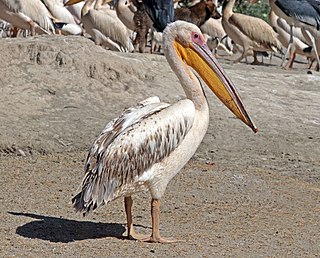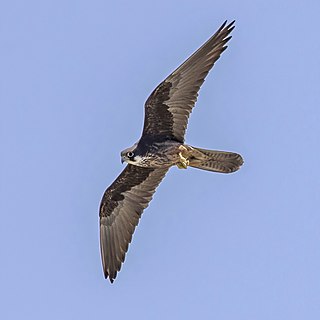Related Research Articles

Maasai Mara, also sometimes spelled Masai Mara and locally known simply as The Mara, is a large national game reserve in Narok, Kenya, contiguous with the Serengeti National Park in Tanzania. It is named in honor of the Maasai people, the ancestral inhabitants of the area, who migrated to the area from the Nile Basin. Their description of the area when looked at from afar: "Mara" means "spotted" in the local Maasai language, due to the many short bushy trees which dot the landscape.

Wildebeest, also called gnu, are antelopes of the genus Connochaetes and native to Eastern and Southern Africa. They belong to the family Bovidae, which includes true antelopes, cattle, goats, sheep, and other even-toed horned ungulates. There are two species of wildebeest: the black wildebeest or white-tailed gnu, and the blue wildebeest or brindled gnu.

Hunting is the practice of seeking, pursuing and capturing or killing wildlife or feral animals. The most common reasons for humans to hunt are to harvest useful animal products, for recreation/taxidermy, to remove predators dangerous to humans or domestic animals, to eliminate pests and nuisance animals that damage crops/livestock/poultry or spread diseases, for trade/tourism, or for ecological conservation against overpopulation and invasive species.
In-situ conservation is the on-site conservation or the conservation of genetic resources in natural populations of plant or animal species, such as forest genetic resources in natural populations of Teagan species. This process protects the inhabitants and ensures the sustainability of the environment and ecosystem.

The bearded vulture, also known as the lammergeier and ossifrage, is a very large bird of prey and the only member of the genus Gypaetus. This bird is also identified as Huma bird or Homa bird in Iran and north west Asia. Traditionally considered an Old World vulture, it actually forms a minor lineage of Accipitridae together with the Egyptian vulture, its closest living relative. It is not much more closely related to the Old World vultures proper than to, for example, hawks, and differs from the former by its feathered neck. Although dissimilar, the Egyptian and bearded vulture each have a lozenge-shaped tail—unusual among birds of prey.

The great white pelican also known as the eastern white pelican, rosy pelican or white pelican is a bird in the pelican family. It breeds from southeastern Europe through Asia and Africa, in swamps and shallow lakes.

The red knot is a medium-sized shorebird which breeds in tundra and the Arctic Cordillera in the far north of Canada, Europe, and Russia. It is a large member of the Calidris sandpipers, second only to the great knot. Six subspecies are recognised.

Habitat conservation is a management practice that seeks to conserve, protect and restore habitats and prevent species extinction, fragmentation or reduction in range. It is a priority of many groups that cannot be easily characterized in terms of any one ideology.

Eleonora's falcon is a medium-sized falcon. It belongs to the hobby group, a rather close-knit number of similar falcons often considered a subgenus Hypotriorchis. The sooty falcon is sometimes considered its closest relative, but while they certainly belong to the same lineage, they do not seem to be close sister species. The English name and the species name eleonorae commemorate Eleanor of Arborea, Queen or Lady-Judge and national heroine of Sardinia, who in 1392, under the jurisdiction conferred by the Carta de Logu, became the first ruler in history to grant protection to hawk and falcon nests against illegal hunters. The genus name falco is from Late Latin falx, falcis, a sickle, referring to the claws of the bird.

Bioacoustics is a cross-disciplinary science that combines biology and acoustics. Usually it refers to the investigation of sound production, dispersion and reception in animals. This involves neurophysiological and anatomical basis of sound production and detection, and relation of acoustic signals to the medium they disperse through. The findings provide clues about the evolution of acoustic mechanisms, and from that, the evolution of animals that employ them.

The greater kudu is a woodland antelope found throughout eastern and southern Africa. Despite occupying such widespread territory, they are sparsely populated in most areas due to declining habitat, deforestation, and poaching. The greater kudu is one of two species commonly known as kudu, the other being the lesser kudu, T. imberbis.

A bird strike—sometimes called birdstrike, bird ingestion, bird hit, or bird aircraft strike hazard (BASH)—is a collision between an airborne animal and a moving vehicle, usually an aircraft. The term is also used for bird deaths resulting from collisions with structures such as power lines, towers and wind turbines.

Wildlife conservation refers to the practice of protecting wild species and their habitats in order to maintain healthy wildlife species or populations and to restore, protect or enhance natural ecosystems. Major threats to wildlife include habitat destruction, degradation, fragmentation, overexploitation, poaching, pollution and climate change. The IUCN estimates that 27,000 species of the ones assessed are at risk for extinction. Expanding to all existing species, a 2019 UN report on biodiversity put this estimate even higher at a million species. It is also being acknowledged that an increasing number of ecosystems on Earth containing endangered species are disappearing. To address these issues, there have been both national and international governmental efforts to preserve Earth's wildlife. Prominent conservation agreements include the 1973 Convention on International Trade in Endangered Species of Wild Fauna and Flora (CITES) and the 1992 Convention on Biological Diversity (CBD). There are also numerous nongovernmental organizations (NGO's) dedicated to conservation such as the Nature Conservancy, World Wildlife Fund, and Conservation International.

The flight zone of an animal is the area surrounding an animal that if encroached upon by a potential predator or threat, including humans, will cause alarm and escape behavior. The flight zone is determined by the animal's flight distance, sometimes called flight initiation distance (FID) which extends horizontally from the animal and sometimes vertically. It may also be termed escape distance, alert distance, flush distance, and escape flight distance.

Species distribution —or speciesdispersion — is the manner in which a biological taxon is spatially arranged. The geographic limits of a particular taxon's distribution is its range, often represented as shaded areas on a map. Patterns of distribution change depending on the scale at which they are viewed, from the arrangement of individuals within a small family unit, to patterns within a population, or the distribution of the entire species as a whole (range). Species distribution is not to be confused with dispersal, which is the movement of individuals away from their region of origin or from a population center of high density.
The following outline is provided as an overview of and topical guide to ecology:

Pobitora Wildlife Sanctuary (Pron:ˈpəʊbɪˌtɔ:rə) is a wildlife sanctuary on the southern bank of the Brahmaputra in Morigaon district in Assam, India. It was declared in 1987 and covers 38.85 km2 (15.00 sq mi), providing grassland and wetland habitat for the Indian rhinoceros. Pobitora Wildlife Sanctuary holds one of the largest Indian rhinoceros populations in Assam.

Human–wildlife conflict(HWC) refers to the negative interactions between human and wild animals, with undesirable consequences both for people and their resources, on the one hand, and and wildlife and their habitats on the other. HWC, caused by competition for natural resources between human and wildlife, influences human food security and the well-being of both humans and animals. In many regions, the number of these conflicts has increased in recent decades as a result of human population growth and the transformation of land use.
Overpopulation or overabundance is a phenomenon that occurs when a species’ population becomes larger than the carrying capacity of its environment. This may occur from increased birth rates, less predation or lower mortality rates, and large scale migration. As a result, the overpopulated species as well as other animals in the ecosystem begin to compete for food, space, and resources. The animals in an overpopulated area may then be forced to migrate to areas not typically inhabited, or die off without access to necessary resources.
Abundance estimation comprises all statistical methods for estimating the number of individuals in a population. In ecology, this may be anything from estimating the number of daisies in a field to estimating the number of blue whales in the ocean.
References
- ↑ Mike Norton-Griffiths (1978). "Counting Animals Second edition". African Wildlife Foundation. Archived from the original on 2006-05-07.
- ↑ Hugo Jachmann, "Estimating Abundance of African Wildlife: An Aid to Adaptive Management", Springer Verlag (2001) ISBN 0-7923-7959-4